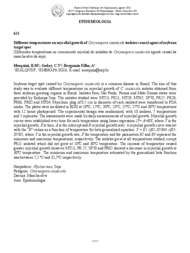Different temperatures on mycelial growth of Corynespora cassiicola isolates causal agent of soybean target spot.
Different temperatures on mycelial growth of Corynespora cassiicola isolates causal agent of soybean target spot.
Author(s): MESQUINI, R. M.; GODOY, C. V.; BERGAMIN FILHO, A.
Summary: Soybean target spot caused by Corynespora cassiicola is a common disease in Brazil. The aim of this study was to evaluate different temperatures on mycelial growth of C. cassiicola isolates obtained from three soybean growing regions in Brazil. Isolates from São Paulo, Paraná and Mato Grosso states were provided by Embrapa Soja. The isolates studied were MT13, PR21, MT29, MT67, SP70, PR27, PR28, PR06, PR02 and MT04. Mycelium plug of 0.5 cm in diameter of each isolated were transferred to PDA media. The plates were incubated in BOD at 10°C, 15°C, 20°C, 23°C, 25°C, 27°C and 30°C temperatures with 12 hours photoperiod. The experimental design was randomized, with 10 isolates, 7 temperatures and 5 replicates. The assessments were made by daily measurements of mycelial growth. Mycelial growth curves were established over time for each temperature using linear regression (Y= A+BX, where Y is the mycelial growth, X is time, A is the intercept and B mycelial growth rate). A mycelial growth curve was set with the ?B? values as a function of temperature for beta generalized equation: Y = B1 ((B2-X)^B4) ((B3-X)^B5, where Y is the mycelial growth rate, X the temperature and the parameters B2 and B3 represent the minimum and maximum temperatures, respectively. The isolates grew at all temperatures studied, except PR21 isolated which did not grow at 10ºC and 30ºC temperature. The increase of temperature caused greater mycelial growth however MT13, PR 27, SP70 and PR02 showed a decrease in mycelial growth at 30ºC temperature. The minimum and maximum temperature estimated by the generalized beta function was between 7,2 ºC and 32,5ºC respectively.
Publication year: 2011
Types of publication: Journal article
Unit: Embrapa Soybean
Keywords: Mancha Alvo
Observation
Some of Embrapa's publications are published as ePub files. To read them, use or download one of the following free software options to your computer or mobile device. Android: Google Play Books; IOS: iBooks; Windows and Linux: Calibre.
Access other publications
Access the Agricultural Research Database (BDPA) to consult Embrapa's full library collection and records.
Visit Embrapa Bookstore to purchase books and other publications sold by Embrapa.

